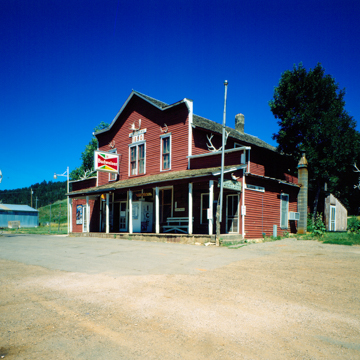You are here
Wyoming Mercantile
The Wyoming Mercantile in the tiny town of Aladdin in northeast Wyoming is one of only a few late-nineteenth-century wooden mercantile buildings remaining in the state. These stores, which served as multipurpose retail and service centers for a dispersed rural population, were once a fixture of small western communities. Today most have closed or been subsumed by larger, single-product stores. Through the years the Wyoming Mercantile has housed a general store, railroad depot, freight station, gas station, saloon, post office, barber shop, and telephone office. It has always been the heart of the community.
Coal was first discovered in the Aladdin area in 1882 and was initially hauled by ox team to Belle Fourche, South Dakota, to be loaded on railcars bound for the gold mines of the Black Hills. The town of Aladdin, named for the genie from Arabian Nights, was patented in 1894 by Amos Robinson, who built the Wyoming Mercantile in 1896. At his death, the property was transferred to Mahlon S. Kemmerer of Pittsburg, Pennsylvania (for whom the town of Kemmerer, Wyoming, was named), who built and owned the Wyoming and Missouri Valley Railroad. This 18-mile line, which opened in 1899, hauled coal from the mines in and around Aladdin and lumber from the nearby Black Hills to Belle Fourche, for transport to the gold mines in Lead and Deadwood. The rail line to Aladdin was abandoned in 1927, after coal production had slowed to the point that the line was no longer profitable. Around this time a rear addition was built on the Mercantile to house a motor car, which transported passengers to and from Belle Fourche.
With its tall false-front facade and open front porch filled with metal lawn chairs, the Mercantile is quickly recognized as a remnant of the “Old West.” The clapboard-clad store consists of a two-story, front-gabled central section flanked by one-story, shed-roofed wings on the east and west, and a shed-roofed addition on the north. The classic false-front facade rises above the eaves, presenting a pedimented parapet to the street. Original long, narrow, 2-over-2, double-hung, Italianate windows are found throughout the building. The facade is adorned with moose and elk antlers. A wooden sign reading “Aladdin, Wyo, 1890,” is set above second-story windows.
The interior, which retains its original wood floors and ceilings and plaster walls, is divided into five rooms on the first floor: the general store, liquor store, post office, store room, and rear addition (now used for storage). The general store retains its original oak food bins and shelves. The five-room second floor is accessed by an exterior wooden staircase at the rear of the building. The building does not have running water, but two wooden privies, respectively labeled “Bucks” and “Does,” are located to the west of the store and a hand water pump is located east of the store.
Aladdin’s location on State Highway 24 between Belle Fourche, South Dakota, and Hulett, Wyoming, makes it a favorite stop for motorcyclists en route to the annual rally in Sturgis, South Dakota, as well as tourists visiting the Black Hills. The Mercantile is the largest and most prominent of about fifteen buildings along both sides of the highway that make up the town of Aladdin. Today the Wyoming Mercantile continues to operate as a general store, post office, and bar/liquor store, where one can purchase groceries, supplies, snacks, clothing, and gardening supplies, as well as hunting and fishing licenses, art and antiques, hardware, and beer.
References
Brown, Mabel, “Wyoming Mercantile,” Crook County, Wyoming. National Register of Historic Places Registration Form, 1991. National Park Service, U.S. Department of the Interior, Washington, D.C.
Writing Credits
If SAH Archipedia has been useful to you, please consider supporting it.
SAH Archipedia tells the story of the United States through its buildings, landscapes, and cities. This freely available resource empowers the public with authoritative knowledge that deepens their understanding and appreciation of the built environment. But the Society of Architectural Historians, which created SAH Archipedia with University of Virginia Press, needs your support to maintain the high-caliber research, writing, photography, cartography, editing, design, and programming that make SAH Archipedia a trusted online resource available to all who value the history of place, heritage tourism, and learning.








